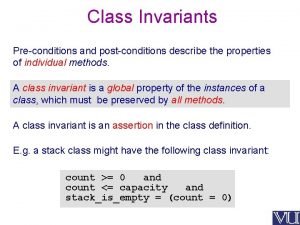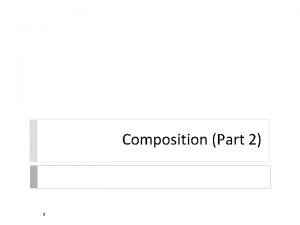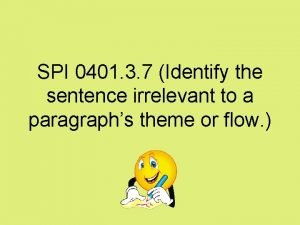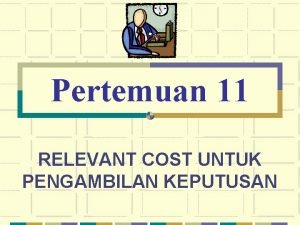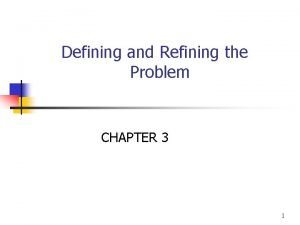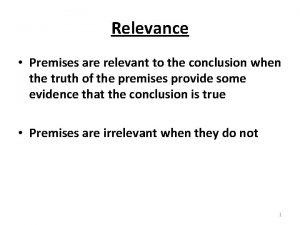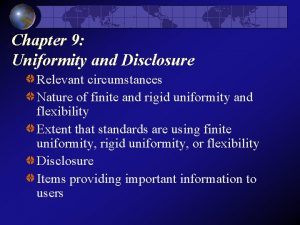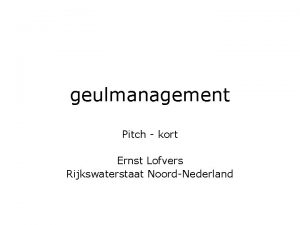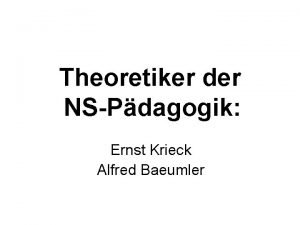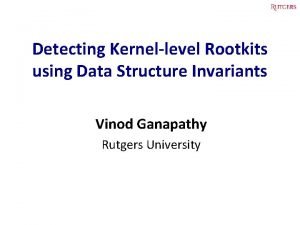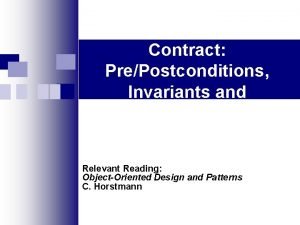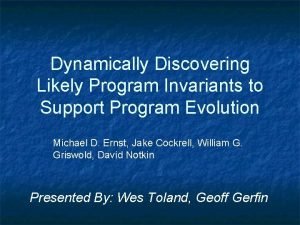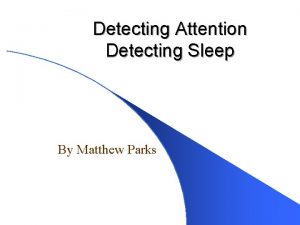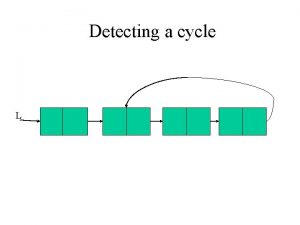Quickly Detecting Relevant Program Invariants Michael Ernst Adam

![Overview Goal: improve dynamic invariant detection [ICSE 99, TSE] Relevance improvements: • add desired Overview Goal: improve dynamic invariant detection [ICSE 99, TSE] Relevance improvements: • add desired](https://slidetodoc.com/presentation_image/4c3288b42cafe63114642906eaa0ae75/image-2.jpg)

![Uses for invariants • • Write better programs [Gries 81, Liskov 86] Document code Uses for invariants • • Write better programs [Gries 81, Liskov 86] Document code](https://slidetodoc.com/presentation_image/4c3288b42cafe63114642906eaa0ae75/image-4.jpg)















![4. Redundant invariants Given: 0 i j Redundant: a[i] a[0. . j] max(a[0. . 4. Redundant invariants Given: 0 i j Redundant: a[i] a[0. . j] max(a[0. .](https://slidetodoc.com/presentation_image/4c3288b42cafe63114642906eaa0ae75/image-20.jpg)





![Related work Dynamic inference • inductive logic programming [Bratko 93, Cypher 93] • program Related work Dynamic inference • inductive logic programming [Bratko 93, Cypher 93] • program](https://slidetodoc.com/presentation_image/4c3288b42cafe63114642906eaa0ae75/image-26.jpg)






- Slides: 32

Quickly Detecting Relevant Program Invariants Michael Ernst, Adam Czeisler, Bill Griswold (UCSD), and David Notkin University of Washington http: //www. cs. washington. edu/homes/mernst/daikon Michael Ernst, page 1
![Overview Goal improve dynamic invariant detection ICSE 99 TSE Relevance improvements add desired Overview Goal: improve dynamic invariant detection [ICSE 99, TSE] Relevance improvements: • add desired](https://slidetodoc.com/presentation_image/4c3288b42cafe63114642906eaa0ae75/image-2.jpg)
Overview Goal: improve dynamic invariant detection [ICSE 99, TSE] Relevance improvements: • add desired invariants (2 techniques) • eliminate undesired ones (3 techniques) Experiments validate the success Michael Ernst, page 2

Program invariants Detect invariants (as in asserts or specifications) • x > abs(y) • x = 16*y + 4*z + 3 • array a contains no duplicates • for each node n, n = n. child. parent • graph g is acyclic Michael Ernst, page 3
![Uses for invariants Write better programs Gries 81 Liskov 86 Document code Uses for invariants • • Write better programs [Gries 81, Liskov 86] Document code](https://slidetodoc.com/presentation_image/4c3288b42cafe63114642906eaa0ae75/image-4.jpg)
Uses for invariants • • Write better programs [Gries 81, Liskov 86] Document code Check assumptions: convert to assert Maintain invariants to avoid introducing bugs Locate unusual conditions Validate test suite: value coverage Provide hints for higher-level profile-directed compilation [Calder 98] • Bootstrap proofs [Wegbreit 74, Bensalem 96] Michael Ernst, page 4

Dynamic invariant detection is accurate Recovered formal specifications, found bugs Target programs: • The Science of Programming [Gries 81] • Program checkers [Detlefs 98, Xi 98] • MIT 6. 170 student programs • Data Structures and Algorithm Analysis in Java [Weiss 99] Michael Ernst, page 5

Dynamic invariant detection is useful 563 -line C program: regexp search & replace [Hutchins 94, Rothermel 98] • • • Explicated data structures Contradicted expectations, preventing bugs Revealed bugs Showed limited use of procedures Improved test suite Validated program changes Michael Ernst, page 6

Dynamic invariant detection Look for patterns in values the program computes: • Instrument the program to write data trace files • Run the program on a test suite • Invariant engine reads data traces, generates potential invariants, and checks them Michael Ernst, page 7

Checking invariants For each potential invariant: • instantiate (determine constants like a and b in y = ax + b) • check for each set of variable values • stop checking when falsified This is inexpensive: many invariants, each cheap Michael Ernst, page 8

Relevance Usefulness to a programmer for a task Contingent on task and programmer We manually classified invariants Perfect output is unnecessary (and impossible) Michael Ernst, page 9

Improved invariant relevance Add desired invariants: 1. Implicit values 2. Unused polymorphism Eliminate undesired invariants (and improve performance): 3. Unjustified properties 4. Redundant invariants 5. Incomparable variables Michael Ernst, page 10

1. Implicit values Goal: relationships over non-variables Examples: • for array a: length(a), sum(a), min(a), max(a) • for array a and scalar i: a[i], a[0. . i] • for procedure p: #calls(p) Michael Ernst, page 11

Derived variables Successfully produces desired invariants Adds many new variables Potential problems: • slowdown: interleave derivation and inference • irrelevant invariants: techniques 3– 5, later in talk Michael Ernst, page 12

2. Unused polymorphism Variables declared with general type, used with more specific type Example: given a generic list that contains only integers, report that the contents are sorted Also applicable to subtype polymorphism Michael Ernst, page 13

Unused polymorphism example class My. Integer { int value; … } class Link { Object element; Link next; … } class List { Link header; … } List my. List = new List(); for (int i=0; i<10; i++) my. List. add(new My. Integer(i)); Desired invariant: in class List, header. closure(next) is sorted by over key. element. value Michael Ernst, page 14

Polymorphism elimination Daikon respects declared types Pass 1: front end outputs object ID, runtime type, and all known fields Pass 2: given refined type, front end outputs more fields Sound for deterministic programs Effective for programs tested so far Michael Ernst, page 15

3. Unjustified properties Given three samples for x: x=7 x = – 42 x = 22 Potential invariants: x 0 x 22 x – 42 Michael Ernst, page 16

Statistical checks Check hypothesized distribution To show x 0 for v values of x in range of size r, probability of no zeroes is Range limits (e. g. , x 22): • same number of samples as neighbors (uniform) • more samples than neighbors (clipped) Michael Ernst, page 17

Duplicate values Array sum program: // Sum array b of length n into variable s. i : = 0; s : = 0; while i n do { s : = s+b[i]; i : = i+1 } b is unchanged inside loop Problem: at loop head, – 88 b[n – 1] 99 – 556 sum(b) 539 Reason: more samples inside loop Michael Ernst, page 18

Disregard duplicate values Idea: count a value if its var was just modified Front end outputs modification bit per value • compared techniques for eliminating duplicates Result: eliminates undesired invariants Michael Ernst, page 19
![4 Redundant invariants Given 0 i j Redundant ai a0 j maxa0 4. Redundant invariants Given: 0 i j Redundant: a[i] a[0. . j] max(a[0. .](https://slidetodoc.com/presentation_image/4c3288b42cafe63114642906eaa0ae75/image-20.jpg)
4. Redundant invariants Given: 0 i j Redundant: a[i] a[0. . j] max(a[0. . i]) max(a[0. . j]) Redundant invariants are logically implied Implementation contains many such tests Michael Ernst, page 20

Suppress redundancies Avoid deriving variables: suppress 25 -50% • equal to another variable • nonsensical (a[i] when i < 0) Avoid checking invariants: • false invariants: trivial improvement • true invariants: suppress 90% Avoid reporting trivial invariants: suppress 25% Michael Ernst, page 21

5. Unrelated variables Problem: the following are of no interest bool b; int *p; b<p int myweight, mybirthyear; myweight < mybirthyear Michael Ernst, page 22

Limit comparisons Check relations only over comparable variables • declared program types • Lackwit [O’Callahan 97]: value flow analysis based on polymorphic type inference Michael Ernst, page 23

Comparability results Comparisons: • declared types: 60% as many comparisons • Lackwit: 5% as many comparisons; scales well Runtime: 40 -70% improvement Few differences in reported invariants Michael Ernst, page 24

Future work Online inference Proving invariants Characterize good test suites New invariants: temporal, existential User interface • control over instrumentation • display and manipulation of invariants Further experimental evaluation • apply to more and bigger programs • apply to a variety of tasks Michael Ernst, page 25
![Related work Dynamic inference inductive logic programming Bratko 93 Cypher 93 program Related work Dynamic inference • inductive logic programming [Bratko 93, Cypher 93] • program](https://slidetodoc.com/presentation_image/4c3288b42cafe63114642906eaa0ae75/image-26.jpg)
Related work Dynamic inference • inductive logic programming [Bratko 93, Cypher 93] • program spectra [Reps 97, Harrold 98] • finite state machines [Boigelot 97, Cook 98] Static inference • checking specifications [Detlefs 96, Evans 96, Jacobs 98] • specification extension [Givan 96, Hendren 92] • other [Jeffords 98, Henry 90, Ward 96] Michael Ernst, page 26

Conclusions Naive implementation is infeasible Relevance improvements: accuracy, performance • add desired invariants • eliminate undesired invariants Experimental validation Dynamic invariant detection is promising for research and practice Michael Ernst, page 27

Questions? Michael Ernst, page 28

Ways to obtain invariants • Programmer-supplied • Static analysis: examine the program text [Cousot 77, Gannod 96] • properties are guaranteed to be true • pointers are intractable in practice • Dynamic analysis: run the program • complementary to static techniques Michael Ernst, page 29

Unused polymorphism example class My. Integer { int value; … } class Link { Object element; Link next; … } class List { Link header; … } List my. List = new List(); for (int i=0; i<10; i++) my. List. add(new My. Integer(i)); Desired invariant: in class List, header. closure(next). element. value: sorted by Michael Ernst, page 30

Comparison with AI Dynamic invariant detection: Can be formulated as an AI problem Cannot be solved by current AI techniques • • not classification or clustering no noise no negative examples; many positive examples intelligible output Michael Ernst, page 31

Is implication obvious? Want: size(top. Of. Stack. closure(next)) = size(orig(top. Of. Stack. closure(next))) + 1 Get: size(top. Of. Stack. next. closure(next)) = size(top. Of. Stack. closure(next)) – 1 top. Of. Stack. next. closure(next) = orig(top. Of. Stack. closure(next)) Solution: interactive UI, queries on variables Michael Ernst, page 32
 Class invariants
Class invariants Class invariant examples
Class invariant examples Michael d. ernst
Michael d. ernst Adam white speaks
Adam white speaks Sniffer for detecting lost mobiles
Sniffer for detecting lost mobiles Detecting evolutionary forces in language change
Detecting evolutionary forces in language change Kerberos silver ticket
Kerberos silver ticket How do fraud symptoms help in detecting fraud
How do fraud symptoms help in detecting fraud Havex
Havex Irrelevant sentence examples
Irrelevant sentence examples Decision making and relevant information
Decision making and relevant information Relevant cost adalah
Relevant cost adalah 5 step decision making process
5 step decision making process Consider all relevant criteria
Consider all relevant criteria Broad problem area example
Broad problem area example Culturally responsive vs culturally relevant
Culturally responsive vs culturally relevant Select significant and relevant information
Select significant and relevant information Anggaran variabel
Anggaran variabel Affirm the antecedent
Affirm the antecedent Cvp income statement format
Cvp income statement format Relevant cost for decision making exercises
Relevant cost for decision making exercises Relevant cost for decision making solution chapter 13
Relevant cost for decision making solution chapter 13 Chapter 11 decision making and relevant information
Chapter 11 decision making and relevant information What are relevant details
What are relevant details Bible is relevant
Bible is relevant Relevant circumstances adalah
Relevant circumstances adalah Chapter 11 decision making and relevant information
Chapter 11 decision making and relevant information Prefetching relevant priors
Prefetching relevant priors Teacher work sample contextual factors
Teacher work sample contextual factors Genghis khan mbti
Genghis khan mbti Chapter 1 managerial accounting and cost concepts
Chapter 1 managerial accounting and cost concepts Decision making and relevant information
Decision making and relevant information Vague questions examples
Vague questions examples
